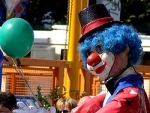|
Add to cart
Product added to the basket The stock is insufficient - units have been added to cart Total:
|
|
Out of stock
|
|
Minimum purchase quantity
The minimum purchase quantity is not reached
|
OUR OFFER
OUR INFORMATION
EXPRESS ORDERS
To learn more about clowns

To learn more about clowns
Character clown
The character clown adopts an eccentric character of some type, such as a butcher, a baker, a policeman, a housewife or hobo. Prime examples of this type of clown are the circus tramps Otto Griebling and Emmett Kelly. Red Skelton, Harold Lloyd, Buster Keaton, and Charlie Chaplin would all fit the definition of a character clown.
The character clown makeup is a comic slant on the standard human face. Their makeup starts with a flesh tone base and may make use of anything from glasses, mustaches and beards to freckles, warts, big ears or strange haircuts.
American character clown types
The most prevalent character clown in the American circus is the hobo, tramp or bum clown. There are subtle differences in the American character clown types. According to American circus expert Hovey Burgess, they are (in order of class):
- The Hobo Migratory and finds work where he travels.
- The Tramp Migratory and does not work where he travels.
- The Bum Non-migratory and non-working.
Emmett Kelly was the preeminent clown of this type. Others include Barry Lubin, Tom Dougherty, Bill Irwin, David Shiner, Geoff Hoyle, John Gilkey, Peter Shub, Poodles Hanneford, Bluch Landolf, Larry Pisoni, John Lepiarz, Bobo Barnett, Happy Kellams, Fumagalli, Charlie Cairoli, Bebe, Jojo Lewis, Abe Goldstein, Rhum, David Larible, Scott Linker, Kenny Raskin, Oleg Popov, Rik Gern, and Bello Nock.
Native American clowning
Many Native Tribes have a history of clowning. The Canadian Clowning method developed by Richard Pochinko and furthered by his former apprentice, Sue Morrison, combines European and Native American clowning techniques.
In this tradition, masks are made of clay while the creator's eyes are closed. A mask is made for each direction of the medicine wheel. During this process, the clown creates a personal mythology which explores his or her personal Experiences and Innocenses.
Rodeo clown
A rodeo clown is a cowboy, or animal wrangler, dressed in wild costumes — almost always oversized and consisting of loose fitting layers of clothing to protect them from, and to distract, rodeo bulls, broncos, etc. The looseness of the layers allows a rodeo clown to shed portions of their attire in the event of its being snagged—as on an enraged bull's horn.
Commedia dell'Arte
There are two distinct types of clown characters, which originated in Commedia dell'Arte but which still hold some favor today, Pierrot and Arlecchino.
Pierrot/Pirouette. Derived from the commedia dell'arte character Pedrolino – the youngest actor of the troupe, deadpan and downtrodden. Although Pedrolino appeared without mask, Pierrot usually appears in whiteface, typically with very little other color on the face. Like Arlecchino, Pedrolino's character changed enormously with the rising popularity of pantomime in the late 19th century, becoming Pierrot. This clown character prefers black and white or other a simple primary color in his or her costume. (le Pierrot is often female, and has also been called "Pirouette" or "Pierrette". When Bernard Delfont was made a life peer, he chose "Pierrot and Pierrette" as the heraldic supporters of his coat of arms.).
Harlequin, or Arlecchino, is a "motley" clown. In the Commedia, Arlecchino always carries a cane with which to strike the other performers, although this cane is normally taken from him by the other performers and used against him. This is believed to be the origin of the slapstickbattacio in Italian), is a prop with two flat flexible wooden pieces mounted in parallel so that the two sticks slap together when the implement is struck, causing a slapping sound, exaggerating the effect of a comedic blow. Despite the slapstick, Arlecchino is not malicious, but mischievous, the slapstick being a classic example of carnivalesque phallic imagery (see also the commedia masks' noses). Like a cross between the characters of Puck and Nick Bottom in A Midsummer Night's Dream, Arlecchino is nimble and adept at the same time as being clumsy and dim, and is normally the 'messenger' character in a comedy — the catalyst for mayhem. Arlecchino has a female counterpart, Arlecchina, or Rosetta, but more often he is in love with the character of Columbina, a straightforward and intelligent maid, who is usually given the prologue and epilogue. Arlecchino has other derivatives with slightly different features: Traccagnino, Bagattino, Tabarrino, Tortellino, Naccherino, Gradelino, Mezzettino, Polpettino, Nespolino, Bertoldino, Fagiuolino, Trappolino, Zaccagnino, Trivellino, Passerino, Bagolino, Temellino, Fagottino, Fritellino, Tabacchino, whose names could all be considered funny-sounding names, even to an Italian. Arlecchino's name is probably derived from "hellech" plus the diminutive suffix "-ino", meaning little devil. In the same way, "Trufflino" is "Little Truffler", Trivellino is (Arlecchino's) "Little Brother", and so on. The Harlequin often loses much of Arlecchino's character in pantomime, as he becomes more of a ballet character, to a large extent stripped of dialogue and subversive content.
|
Alert
Please enter the required fields! |